The history of water in San Remo
(edited by Roberto Monfroni)
The history of the aqueducts
The scarcity of water in Western Liguria and in particular in Sanremo has always been a big problem in the past centuries and therefore we cannot avoid talking about the arrival of water in Sanremo.
The water supply of Sanremo has always been a problem and until 1828 the water arrived by occasional ways.
In the upper part of the city (la Pigna) the water, coming from underground aquifers or meteoric (rain, etc.) was stored in tanks scattered here and there, from which the various place names derive such as Via Cisterna, vicolo Cisternin or "funtanassa" to which a collection tank was annexed.
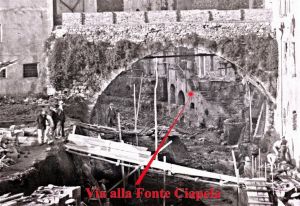 In the flat part of the town, the system of wells (which fetched water from the few aquifers in the subsoil or from meteoric sources) and cisterns, in which water supplies were kept for periods of drought, was the only one in existence, and therefore the only one that allowed for water supply.
In the flat part of the town, the system of wells (which fetched water from the few aquifers in the subsoil or from meteoric sources) and cisterns, in which water supplies were kept for periods of drought, was the only one in existence, and therefore the only one that allowed for water supply.
The water extracted from the subsoil, however, as a doctor and hygienist of the time wrote, was « impure and slimy water, the source of gastroenteropathies, tapeworms, typhoid fevers, aso. ».
At the time, the water was supplied by a spring in the San Romolo stream, known as the Ciapéla spring, named after the homonymous bastion erected at the time as part of a defensive system against the Saracen invasions.
Located very low down, it was accessed by two flights of stairs.
For the vegetable gardens, irrigation was by deriving water from the streams or, where possible, from underground by digging wells. The water from the streams was collected by means of dams or sluices (ciüüse) across the watercourses and channelled along the banks of the valley into special earthen or masonry gutters (bii) and brought, by natural fall, to irrigate the land below in the respective valley. 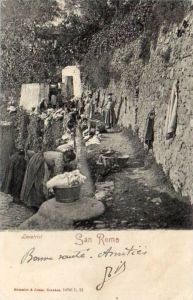 Since the waters of the torrents, which were certainly not abundant, were state-owned, the institution of "devéu", or prohibition of drawing water by individuals to the detriment of others, had the force of law.
Since the waters of the torrents, which were certainly not abundant, were state-owned, the institution of "devéu", or prohibition of drawing water by individuals to the detriment of others, had the force of law. 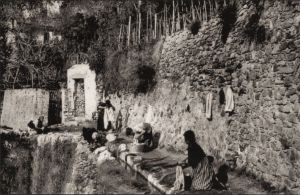 During the hot season and on certain days of the week, municipal employees swore an oath to assign each user his share of the water, set in hours and minutes, opening and closing special openings (turseùi) in correspondence with the garden to be irrigated, allowing the passage of the precious but scarce element. The ringing of a bell marked the beginning and end of the allocation.
During the hot season and on certain days of the week, municipal employees swore an oath to assign each user his share of the water, set in hours and minutes, opening and closing special openings (turseùi) in correspondence with the garden to be irrigated, allowing the passage of the precious but scarce element. The ringing of a bell marked the beginning and end of the allocation.
With this system, the lands were considered sut'àiga (under the water), i.e. downstream of a water course and therefore of greater value than those located upstream, unable to enjoy such benefits. Of course, the system was not without its faults, and sometimes violent disputes broke out due to the failure to respect the time limits and the farmers' respective rights.
In some cases, the water along the path in the biu was also used as motive power for the numerous olive presses or mills and in the sections of biu made of masonry, the women spent hours and hours washing their clothes in running water.
Nowadays, there are only a few lost remnants of these biu here and there, bearing witness to a past of sacrifice and hard work. (from the Magazine "A Gardiöra no. 2 of 1985").
It was only thanks to Siro Andrea Carli, who was elected mayor on 24 February 1827, that his first initiative was to tackle the problem of the city's water supply, which urgently needed new sources in addition to those mentioned above, as the people of San Remo had been suffering from drought for some time and were forced to draw water from a number of wells.
With the support of the Intendant Alberto Nota, he made his project known to the population. The inhabitants of Sanremo enthusiastically accepted the proposal and both rich and poor competed to help with the work by lending themselves to all the heavy transport services for the building materials. However, there was fierce opposition to the implementation of the aqueduct project and an appeal was lodged with the Intendancy against the Council Resolution (24 April 1828) on the grounds of « the damage to the waters used to water the lemon gardens and to run the oil and grain mills" and because it was feared "that it would be very difficult to bring water to the town with the success desired and believed ».
The town council then commissioned the senior aide of the Royal Corps of Civil Engineers, Gio Batta Luigi Clerico, to find a spring in the Sanremo area capable of supplying water to the town, which was eventually identified as the one situated on the slopes of the Pian di Castagna mountain, in the locality of Lago Nero.
It was therefore thanks to the magnanimity of the Ammirati family, with a regular deed of the Notary Francesco Donetti dated 21 October 1828, that « they were pleased to grant this Magnificent Community a free concession of a spring of water rising in their woodland and chestnut woods in this territory called Breschi, near the so-called Lago Negro ». On 2 August of the same year, they made only one petition, in which, although they knew that the water channel would benefit all the inhabitants of the town, they asked that « the water conducted in the channel be used for the profit and advantage of the same, i.e. of their land situated in the place called Cardellina, or Gogna, which is lower down and adjacent to the canal, a trickle of water of the volume of half an ounce of Genoa, so that they could use it to irrigate their land under cultivation, after the same water had been used by the public, in a fountain to be erected in another of the upper parts of the land ».
Naturally this request was approved by the Municipality, which wrote: « We approve and give due praise to the zeal of Mr and Mrs Ammirati for the voluntary and free concession of a water belonging to them. Sanremo 25 September 1828, the Intendant notes ».
Some technical data: According to the existing data in the Municipality the length of the canal, from the spring to the Porta di San Nicola (Porte di Santa Maria), was 4,136 metres, with a difference in level of 317.71 metres. The canal was made of masonry, 0.20 metres wide, 0.16 metres high, with a curved bottom and covered with slabs. In addition, there were 757 metres of well-painted terracotta pipes, 0.50 metres long, 0.12 metres in diameter, set 0.08 metres apart to carry water from 399 metres before the Porta di San Nicola (St Nicholas Gate) to the various fountains in the town, a total distance of 4,971.20 metres.
The tanks were and are made of Balzi Rossi limestone and their construction was contracted and approved on 17 June 1828 to Francesco Serra di Vincenzo.
After the construction of the aqueduct and the overcoming of a number of disputes concerning the state, on 15 August 1829 the water was finally able to flow for the first time and reach the various districts of the city through special branches of the pipes, making it possible to build four fountains: in Piazza dei Dolori, Piazza Santo Stefano, Piazza del Mercato, and later the fountain in Piazza dei Missionari.
Of the fountains built, those in Piazza dei Dolori, Piazza Santo Stefano (or Piazza Nota) and Piazza dei Missionari (today Piazza Bresca) still retain their original design.
To celebrate the happy event, the Piacenza man of letters Pietro Giordani wrote an epigraph that was walled on an aqueduct pipe along the road that leads from the sanctuary of the Madonna della Costa to the village of San Giacomo. The text of the epigraph, which was allegedly destroyed by a vandal in 1885, read as follows: « MDCCCXXVI / The Council of the Municipality / at the request of Alberto Nota R.° Intendente / by A. Carli Sindaco / in the city that drank scarce and guilty / led for more than VM metres / excellent water / overcame the difficulties of the work / greatly shortened the time and expenses / by universal and general concurrence / of every order of citizens ».
The importance of having access to clear, fresh water was very much felt by the citizens, since, as Francesco Onetti would point out: « Drinking water is healthy when it is clear, odourless, with a pleasant taste..., when it cooks dry vegetables and meat with alacrity, and dissolves soap well without becoming cloudy or producing any pollution ».
Until the 1860s, the town's overall water supply was adequate for its needs. The two hundred cubic metres of water from the Lagonero spring were almost exclusively used as drinking water, while water from wells was preferred for domestic and irrigation purposes.
It was in the 1970s that the problem of an increased and improved water supply became apparent. In the course of that decade, in fact, the resident population grew considerably and the number of tourists increased, as did municipal needs and individual consumption due to changes in hygiene habits.
Thus, in 1876, the municipal council resolved to set up a commission to study a water diversion from the Roja river, which would have allowed a large supply, able to meet the needs of agriculture as well. Towards the end of the decade, a call for tenders was issued and several companies were asked to submit suitable projects to the council.
In the meantime a government concession for the exploitation of the river had been obtained, but no entrepreneur came forward with projects to submit to the municipal councillors, probably because of the great distance of the Roja river from Sanremo and the impervious nature of the territories to be crossed, factors that imposed costly studies and the resolution of difficult hydraulic engineering problems.
It was on the initiative of the liberal-catholic administration of Bartolomeo Asquasciati (1878-1891) that the programme for an Aqueduct adapted to the new needs of the city was developed.
In spite of the short-sightedness of many of his fellow countrymen, who out of misery, or out of modest and unhygienic conceptions of life, or out of sterile private interests (such as defending against the uprooting of some lemon or even olive trees along the route of the work, or because of a wild and antisocial concept of property rights with regard to the workers assigned to temporary public works on their land) did not see the civil necessity of building an aqueduct to provide the city and its agriculture with abundant water, Asquasciati, overcoming all this resistance, sponsored and carried out (he did not propose programmes except to implement them) the grandiose work of a Municipal Aqueduct.
Before then, in the city, water was fetched from the fountain by bucket, and these fountains by the well-deserving Siro Andrea Carli were in any case insufficient for the growing population. In the countryside, if there was a well on any land, the owner's garden or field was envied and longed for by the neighbours as if it were a Promised Land.
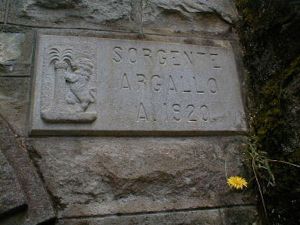
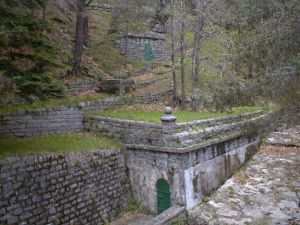 This brought us to 1882, the year in which an agreement was finally reached, and then finalised in a contract, with the Société Lyonnaise del Eaux et Eclairage, which undertook to bring to Sanremo not the waters of the Roja, but those of the Argallo springs, already purchased to supply Ospedaletti. The Société Lyonnaise undertook to build a pipeline capable of supplying 4,000 cubic metres per day to Sanremo and 200 to Ospedaletti, which would be reached by a branch line. Furthermore, as soon as the town had obtained the government concession, the transalpine company undertook to increase the cubic metres for Sanremo to 7,500, by diverting water from the Oxentina river.
This brought us to 1882, the year in which an agreement was finally reached, and then finalised in a contract, with the Société Lyonnaise del Eaux et Eclairage, which undertook to bring to Sanremo not the waters of the Roja, but those of the Argallo springs, already purchased to supply Ospedaletti. The Société Lyonnaise undertook to build a pipeline capable of supplying 4,000 cubic metres per day to Sanremo and 200 to Ospedaletti, which would be reached by a branch line. Furthermore, as soon as the town had obtained the government concession, the transalpine company undertook to increase the cubic metres for Sanremo to 7,500, by diverting water from the Oxentina river.
The studies for the canalization had already begun when serious problems arose between the French engineers and the populations of Badalucco, Vignai and Zerbi, who valued centuries-old usufruct rights over the springs that were about to be introduced into the conduits. The Société Lyonnaise thus cancelled the contract and was replaced by the engineer Giovanni Marsaglia, who took over the task of supplying the town on the same terms as the transalpine company.
The contract, drawn up on 12 July 1883 between the town council and the Marsaglia company, was based on the following points: the municipality granted the entrepreneur the exclusive right to occupy public land free of charge for the construction of the drinking water pipeline; the duration of this concession was eighty years, after which the aqueduct would become the property of the town; the entrepreneur had to guarantee the purity of the water, which the council was entitled to have analysed periodically; the water was to be drawn for 4. 000 cubic metres per day from the springs at the foot of Monte Ceppo and subsequently for a further 3. 500 cubic metres from the Ossentina torrent; the Town Council allowed 200 cubic metres of water not included in the calculation to be taken to Ospedaletti; the surplus water was to be used for industrial and agricultural purposes at reduced prices; 1,000 cubic metres per day were to be allocated to the Town Council for the hygiene needs of the town; the quantities of water from private subscriptions were to be poured over the course of the day into the collection tanks belonging to the subscribers; the public fountains were to be increased by one per thousand inhabitants.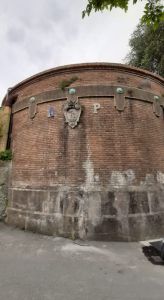 The aqueduct was inaugurated on 12 March 1884. The springs that fed it came from an average altitude of 900 metres above sea level. It was hermetically sealed and built partly of stone and concrete and partly of cast iron. It crossed the Oxentina and Armea valleys and had a total length of 25 kilometres, much of which was covered by water under forced pressure.
The aqueduct was inaugurated on 12 March 1884. The springs that fed it came from an average altitude of 900 metres above sea level. It was hermetically sealed and built partly of stone and concrete and partly of cast iron. It crossed the Oxentina and Armea valleys and had a total length of 25 kilometres, much of which was covered by water under forced pressure.
In Poggio, there was a first large collection tank called "del Poggio" and a second one called "degli archi", built along the San Romolo mule track.
At Argallo there was a pump that raised the water from the springs depressed with respect to the pipeline. This was a great achievement of hydraulic engineering, carried out with the best materials and the most advanced technology.
« The Asquasciati with the Argallo aqueduct, built by the engineer Giovanni Marsaglia, provided San Remo with a healthy and abundant irrigation. (A.N.Brizio. "Au Pays du Soleil". History of Sanremo. 54° - 4 ») .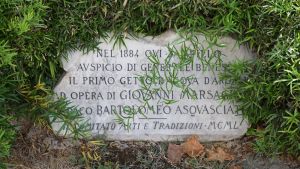 Near the fountain, known as the "Zampillo", a plaque was placed in 1950 to recall how, « in 1884, thanks to the merits of Marsaglia and Mayor Asquasciati, water from Argallo "gushed" for the first time ».
Near the fountain, known as the "Zampillo", a plaque was placed in 1950 to recall how, « in 1884, thanks to the merits of Marsaglia and Mayor Asquasciati, water from Argallo "gushed" for the first time ».
The construction of the aqueduct implied a considerable burden for the town, but the town council did not hesitate to decide on it and even pressured for a quick completion. An increased water supply was necessary to solve the hygiene issue and sufficient water had to be supplied to the foreign colony if it was to establish itself as an international health resort. The problem of costs was thus overshadowed, and tourism, now the city's main source of wealth, could not be neglected.
But it was not enough for the town hall to finally build the aqueduct, the municipal authorities wanted above all to link San Remo to a symbol and demanded a grandiose pipeline, capable of attracting the attention of the Riviera's tourist clientele.
The contract envisaged an aqueduct capable of delivering 7,500 cubic metres of water per day, something like 90 litres per second and 450 litres per inhabitant per day. Nice, the first city in France, boasted 300 litres per inhabitant per day, Paris 90, Berlin 54 and London 141. In Italy Genoa had 120 litres, Livorno 27 and Lucca 24. With the construction of the aqueduct San Remo became one of the best supplied European towns in the 19th century.
Of this great quantity of water, as said, one thousand cubic metres per day belonged to the Municipality, to supply the public fountains and the wash-houses (at the end of the century there were thirty of the former and three of the latter), to water the streets and to rinse the sewers and the white canals. These tasks, however, absorbed much more than the amount agreed with the concessionaire, reaching almost 1,500 cubic metres, broken down as follows: 500 for the fountains, 500 for the wash-houses and the remaining third for the hygiene of the town, for which the municipality had about 150 watering points at the end of the century.
The municipal authorities were always able to make use of this considerable volume of water, but the total quantity brought by the pipeline to San Remo throughout the 19th century was never more than 7,500 cubic metres per day. In fact, once the water from the Argallo springs arrived in the city, in the amount of 4,000 cubic metres, all the needs were met and there were large surpluses. The Municipality therefore did not proceed with the request to exploit the waters of the Ossentina and the concessionaire considered himself relieved of the obligation to supply the agreed 7,500 cubic metres.
But if the municipal authorities remained inactive, the same was not true of the Marsaglia company, which purchased the springs that fed the Ossentina and fed them into the aqueduct, but exploited the new volume of water to the advantage of Porto Maurizio, which was connected by a branch that supplied 800 cubic metres a day. Sanremo claimed the new quantity of water for itself and asked the concessionaire, now that the waters of the Ossentina were available, to meet the agreed supply of 7,500 cubic metres. The result was an interminable dispute that went from the Sanremo tribunal to the Genoa Court of Appeal and the Turin Court of Cassation.
What prompted the municipality's dispute with the Marsaglia company was, unbelievably, the problem of the water shortage which, only ten years after the aqueduct was put into operation, was recurring.
The fact is that not only was the city not using the 7,500 cubic metres originally agreed, but it was also not using the 4,000 cubic metres from the Argallo springs. In fact, the Argallo springs had a capacity of less than the calculated 50 litres per second during the summer season. In the 1990s, the municipality absorbed about 1,500 cubic metres for public needs and about 1,000 cubic metres were absorbed by private subscriptions. This resulted in a minimum consumption of around 2,500 cubic metres, which was often barely met in summer, especially when it did not rain for long months. In short, the city, which should have had one of the first aqueducts in Europe in proportion to its population, could hardly meet the needs of its users and was in serious difficulty when faced with requests for new subscriptions.
The problem, especially if projected into the future, was so serious that it could not even be solved by recovering the 800 cubic metres of water allocated by the concessionaire to Porto Maurizio. It was imperative to obtain all the available springs at the Ceppo aqueduct in order to significantly increase the capacity of the aqueduct.
It was possible to do both, and in the new century the water supply problem was finally solved. The pipeline, which after yet another dispute with the Marsaglia company was municipalised, was put in a position to work at its maximum flow rate, which was 9,000 cubic metres in the «free surface» section leading to the Poggio reservoir and 6,500 cubic metres per day in the «high pressure» section leading to the "archi" reservoir.
At the end of the first decade of the 20th century, the maximum supply of the springs administered by the municipality amounted to 9,000 cubic metres per 24 hours, while the minimum volume of water obtained in summer was 4,500 cubic metres. However, this latter quantity could be increased by 1,000 cubic metres by piping water from two reserve springs, Argenta and Lauretta, located near Vignai. Meanwhile, the demand for drinking water was increasing.
In 1906 there were 1,525 subscribers, with a daily consumption of 1,720 cubic metres; in 1909 there were 1,697 subscribers, with a daily consumption of 2,120 cubic metres. These figures did not include Ospedaletti's commission (200 cubic metres), nor did they include the amount consumed by the municipality for public services (1,500 cubic metres) or to start up the turbines of the municipal electric plant (1,500 cubic metres).
In 1910 the Marsaglia aqueduct was municipalised, as mentioned above, and the Azienda Autonoma Municipalizzata per l'Acquedotto e l'energia Elettrica (AAMAIE) was created.
At the same time, two hydroelectric groups were put into operation, using the water for this purpose.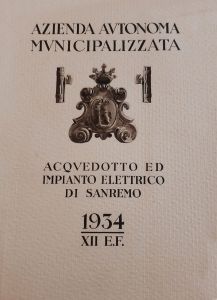 But once again one of the city's main issues was dissolved for the exclusive benefit of the foreign colony and the wealthy San Remo residents.
But once again one of the city's main issues was dissolved for the exclusive benefit of the foreign colony and the wealthy San Remo residents.
This was the case for many urban planning and hygiene problems, which had been solved in the tourist districts and in the new city business centre, but had been left unresolved in the old districts where the immigrants and the lower classes of the local population were concentrated. 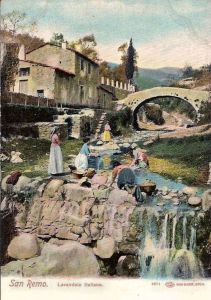 This was the case with the problem of drinking water, the distribution of which was organised for the exclusive benefit of guests and the rich indigenous bourgeoisie.
This was the case with the problem of drinking water, the distribution of which was organised for the exclusive benefit of guests and the rich indigenous bourgeoisie.
The fact is that subscribers who were supplied with water had to pay such high tariffs that the people of San Remo continued to draw water from public sources and store it in jars throughout that period, without having any direct connection in their homes. It was true that, between 1870 and 1900, both the number of fountains and the cubic metres of water dispensed from them had tripled, but it was also true that the population of the town had doubled during this period.
The effective litre/inhabitant ratio had therefore only slightly improved, and the inconvenience to which the people of Sanremo were subjected had only slightly reduced.
It was certainly not much, and the well system was slow to disappear.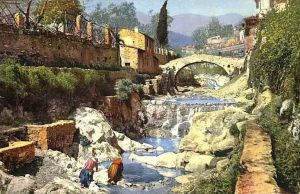 On the contrary, the quantity of water consumed by the privileged subscribers reached the then unbelievable levels of a thousand litres a day. But the wealthy lived in villas surrounded by large gardens that needed watering and they had by then all applied in their homes the latest innovation produced by the hydraulic-sanitary knowledge of the time, the water-closet, which "wasted" dozens of litres of water per day per family for flushing the latrines.
On the contrary, the quantity of water consumed by the privileged subscribers reached the then unbelievable levels of a thousand litres a day. But the wealthy lived in villas surrounded by large gardens that needed watering and they had by then all applied in their homes the latest innovation produced by the hydraulic-sanitary knowledge of the time, the water-closet, which "wasted" dozens of litres of water per day per family for flushing the latrines.
It was because of these very high levels of consumption that, despite the low number of subscriptions, what seemed to be an inexhaustible supply of water in 1885 soon became insufficient, even though from the year the system began operating, new springs were gradually introduced to increase the water supply.
Before starting the construction of the pipeline, the Marsaglia company, and previously the Société Lyonnaise des Eaux et d'Éclairage, had calculated the city's daily water requirements using the French system, which had also been applied in Nice, and had thus come to the conclusion that the 4,000 cubic metres of water from the Argallo would be largely sufficient for the city's needs and that the 3,500 cubic metres from the Ossentina would be able to cope with the new demands that the increase in population would bring.
According to this system, average consumption was calculated as 20 litres per day per person, 5 litres per worker, 5 litres per school, college or boarding school pupil and 10 litres per soldier, 60 litres per horse, 40 litres per cow, 60 litres per four-wheeled car, 40 litres per two-wheeled car, 3 litres per square metre of flowerbeds and gardens and 150 litres per day for warehouses and shops. But these parameters, which in the 1980s were considered serious, ten years later seemed inadequate for calculating the water requirements of a centre of the size and prestige of Sanremo. And if the situation was not as disastrous as these figures would suggest, it was due to the fact that the pipeline served only a limited number of San Remo residents, in addition to their wealthy guests, of course.
The actual amount of water available to the majority of citizens and the inconveniences that most of them had to face in order to procure their daily water needs were not of much interest to the administrators. The objectives they had set themselves, and which they considered important for the future of San Remo, were to provide tourists with plenty of water and to improve the hygienic conditions of the city through a consistent water supply. And these objectives were both achieved.
Needless to say, it was only from then on that flower cultivation, which required so much irrigation, was consolidated, and it is also superfluous to enumerate the immense advantages that the Aqueduct brought to the city's hygiene and to agriculture in general, apart from the particular cultivation of flowers.
Although at the beginning of the 20th century the water situation seemed to have stabilised, the continuous expansion of the city in terms of both buildings and population, until after the Second World War, increased the need to increase its water supply.
Thanks to the intervention of AAMAIE, further sources of supply were added from 1910 onwards; in particular: the subalvea aquifer of the Argentina torrent, with its wells and pumping station (1926).
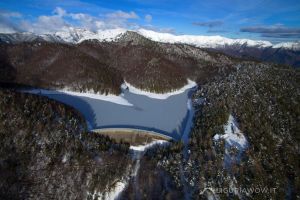 In 1963, with the construction of the Tenarda Dam, in the upper Nervia Valley, an artificial reservoir was created, which can hold about 2 million m3 of water, supplying water, by natural gravity, to a large part of the Sanremo territory.
In 1963, with the construction of the Tenarda Dam, in the upper Nervia Valley, an artificial reservoir was created, which can hold about 2 million m3 of water, supplying water, by natural gravity, to a large part of the Sanremo territory.
However, in periods of long drought, which had affected Western Liguria for centuries, water was sometimes in short supply, especially on the highest floors of the buildings built after the war, and again the idea of 1876 to bring the waters of the Roja river, which has its source in the Piedmont/Ligurian Alps and is rich in springs, to the coast was taken up again, solving once and for all the water problem that existed not only in Sanremo but also as far as Imperia and Diano Marina and beyond.
The pipelines were built in successive phases: from 1970 to 1981 as far as Capo Verde (the Cape between Sanremo and Arma di Taggia), passing partly by land and partly under the coastal sea; later, still passing by sea, the pipelines reached Andora, completing the work in 1999.
Now the water is there, it is only a question of maintaining the pipelines, especially the older ones, to prevent a commodity that is so precious to the life of coastal towns from being wasted.
Nowadays Sanremo is sown by a large number of fountains and drinking fountains, but we will limit ourselves to dealing only with the "historical" ones and the most characteristic ones which accompanied the years of the last century.
(Sources: free elaboration taken from:
book "Siro Andrea Carli - Sindaco Benemerito 1797 - 1857 " published by the "Comitato Arti e Tradizioni - Sanremo" 1962;
Dr Andrea Gandolfo from "La Grande Storia di Sanremo" fifth volume;
Massimo Scattareggia "Sanremo 1815 - 1915" tourism and territorial transformations;
I would like to thank Dino Taulaigo, Sergio Carbonetto and Giacomo Mannisi for their cooperation;
News and illustrations from WEB searches; historical images from private archives)




